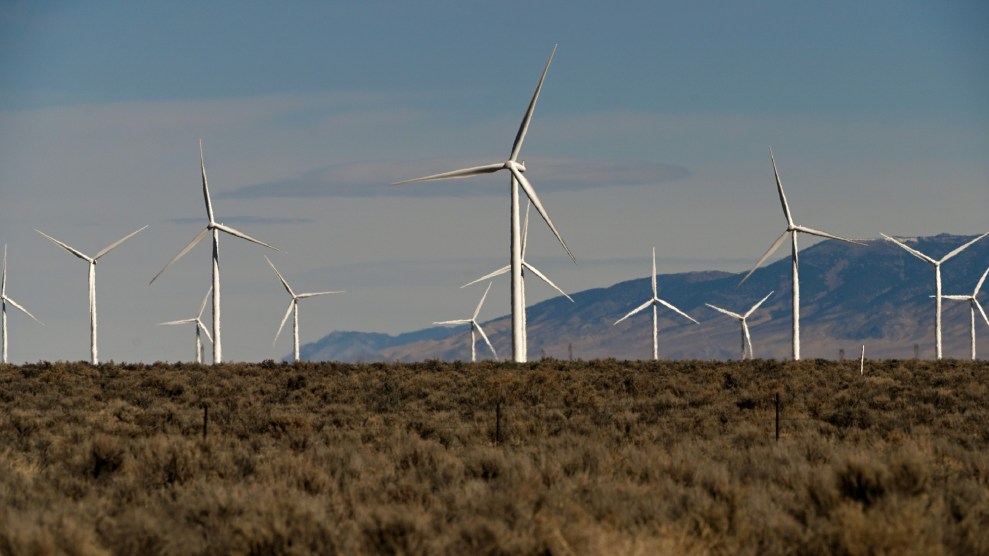
Spring Valley Wind, a wind farm in Eastern Nevada, was built on federal land near Great Basin National Park.. David Becker/ZUMA Wire
This story was originally published by High Country News and is reproduced here as part of the Climate Desk collaboration.
In 2021, President Joe Biden signed an executive order on the climate crisis that, among other things, directed the secretary of the Interior to review the potential for clean energy on public lands. Later that year, he set aggressive national targets on green energy: 80% renewable energy generation by 2030 and 100% carbon-free electricity by 2035. Then came the passage of the historic Inflation Reduction Act, which showered the clean energy industry with federal incentives and encouraged private investors to cash in on its explosive growth.
Since Biden’s inauguration, his administration has approved a steady stream of solar, geothermal, and transmission projects across the West. In April, the Interior Department announced that it had permitted more than 29 gigawatts of renewable energy on public lands—an amount nearly equivalent to the total capacity of Washington or Arizona. In the following months, it released a suite of new agency rules and a regional plan aimed at boosting regulatory certainty for clean energy development for years to come.
“2024 felt like the year where all the pieces finally came together,” said Rachael Hamby, policy director for the Center for Western Priorities, a nonprofit that advocates for clean energy and conservation in the West. “A lot of that groundwork has been laid over the past four years, and we’re seeing the culmination of all of that progress.”
But former President Donald Trump’s win in November casts a cloud of doubt over the future of those changes. It’s unclear how the incoming administration will treat existing permits and policies favorable to clean energy. Some experts, however, wager that some of this year’s developments—particularly those that benefit the energy industry at large—could survive; they were, in fact, carefully built to last.
Here are a few of this year’s major developments in public-land clean energy, along with some thoughts on how they might fare in the next four years:
The Western Solar Plan designated more than 31 million acres of public land for potential utility-scale solar development.
In August, the Bureau of Land Management published the final version of a West-wide plan that opens large swaths of federal land to industrial-scale solar permits while protecting the rest for its cultural or ecological significance. Environmental groups had hoped the BLM would keep the map more limited to protect natural landscapes; after all, meeting the nation’s climate goals requires only 1 million acres of public land. The final version, however, opened roughly four times as much land as environmental groups recommended, including part of the proposed Bahsahwahbee National Monument in Nevada.
By opening up such a large area, the administration seemed to favor industry, which will benefit from greater flexibility for siting projects. John Leshy, a professor at UC Law San Francisco and former general counsel for Interior during the Clinton years, said the plan reflects a careful balance between stakeholder groups, adding that Trump’s pick for Interior secretary, North Dakota’s Republican Gov. Doug Burgum, may choose to keep the plan intact. (Burgum pledged an “all-of-the-above” energy strategy for his home state, which receives a third of its energy from wind power, and he may well do the same at the national level.)
Patrick Donnelly, Great Basin director for the Center for Biological Diversity, believes that Biden’s plan is the opposite of balanced; he said it exposes far too much of the nation’s natural resources to development. Still, he said, in some regions it was an improvement on the previous permitting framework, which focused primarily on southern Nevada. In any case, he added, “That plan is not going to last. It’ll be gone by summer; that’s my prediction.”
New transmission lines are set to unlock massive energy expansion in the West.
In 2024, the BLM advanced three major transmission lines in Nevada, including Greenlink North, which cuts horizontally across the center of the state; Greenlink West, which runs along its diagonal southern edge; and the Cross-Tie transmission line, which connects substations in Nevada and Utah. Together with the Western Solar Plan, these transmission lines boost the likelihood that Nevada’s public lands will host numerous utility-scale solar projects, a stark reality that has alarmed local leadership.
Transmission lines are critical for the clean energy industry because they allow providers to allocate power more efficiently across regions. In practice, however, these lines frequently transfer both clean energy and fossil fuel-derived power, making them appealing to both sectors of the industry. This year, the Biden administration also sped up permitting times for transmission projects, possibly paving the way for even more construction in the future.
Domestic clean energy supply chains necessary for energy independence ramped up.
Clean energy manufacturing relies on a steady supply of critical minerals. After decades of growing reliance on other countries, bringing clean energy supply chains back to the United States—thereby increasing the nation’s energy independence—was a central pillar of the Biden administration’s climate goals. In 2024, the Interior Department pushed ahead on several major critical mineral projects, including a lithium mine and processing facility in Nevada, a gold and antimony mine in Idaho, and a zinc and manganese mine in Arizona.
Some mines, however, come at a great cost to ecosystems and tribal cultural sites: According to members of the Western Shoshone and environmental groups, the Nevada lithium mine would destroy a fifth of the critical habitat designated for an endangered wildflower, the Tiehm’s buckwheat, and also harm the Cave Spring sacred site.
Next year, the Trump administration is expected to slash funding from the Inflation Reduction Act, reducing financial incentives for domestic mining projects. However, securing critical minerals—which are key to military and technology equipment as well as to clean energy—will likely remain a priority throughout his term.
New agency rules lowered the costs of clean energy development on public land while raising fees for oil and gas.
This year, the Interior Department finalized three major policies: lowering rent and lease fees for renewable energy projects on public lands; raising related fees for oil and gas projects; and elevating conservation to become a key consideration for the Bureau of Land Management, alongside food, energy, recreation and other uses. Together, these changes aim to support renewable energy development on public lands by reducing required payments and providing options to mitigate environmental harm.
These rules took a tremendous amount of time and effort to put into place, said Hamby, of the Center for Western Priorities, and that was by design: It means that if the next administration wants to unravel them, it will have to follow the same comprehensive, multi-year procedure it took to create them. The US Congress or new agency leadership could still undo each rule, but given that they reflect both industry and community priorities, they retain some broad appeal.
Hamby also pointed to the sheer amount of private investment and market transformation over the past four years, which the new rules only accelerated. “The effect of a lot of this has been to generate momentum for the clean energy transition in the US,” she said. “That is going to be hard to put the brakes on.
















